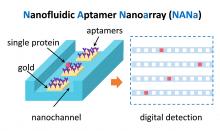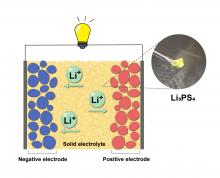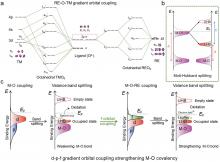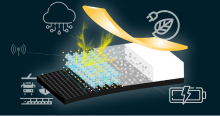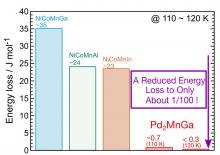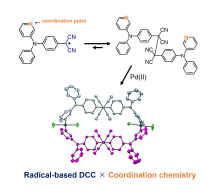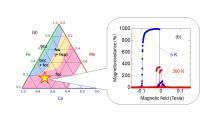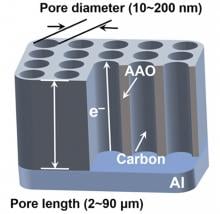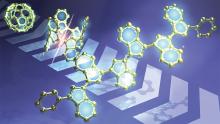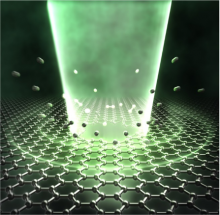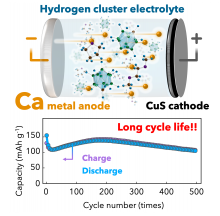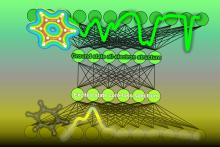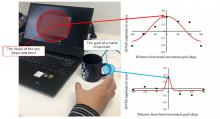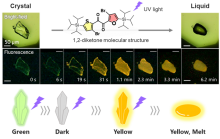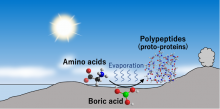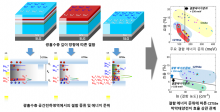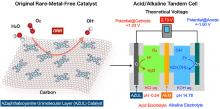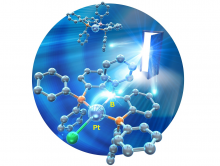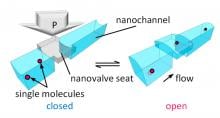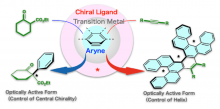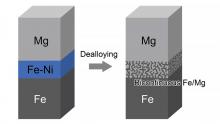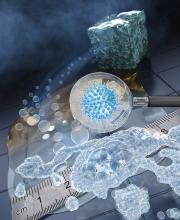Chemistry
News
23 Jun 2023
An international team led by Professor Yan Xu from Osaka Metropolitan University has developed a groundbreaking nanofluidic device, named NANa, capable of stochastically capturing and digitally detecting individual proteins at cellular concentrations. This tool, vital for precision medicine, is designed to handle tiny volumes equivalent to a single cell's contents and can identify single biomolecules even in high-concentration environments. The team plans to conduct further demonstrations using actual cell samples and explore the integration of this tool with AI and biological big data. This research could potentially revolutionize personalized disease prevention and treatment.
21 Jun 2023
Osaka Metropolitan University researchers succeeded, for the first time, in stabilizing the high-temperature phase of Li3PS4—a solid electrolyte material¬¬—thus attaining high ionic conductivity even at room temperature, using a method of rapid heating during its crystallization. This unprecedented achievement is expected to contribute to the development of materials for all-solid-state batteries with higher performance.
19 Jun 2023
A key protein for sperm maturation identified, Understanding gel formation, Urine test predicts organ diseases, A laser drills holes in a graphene film. Plus in our blog - The frogs of Borneo: more than just a race. Read all in the latest Editor's Choice.
19 Jun 2023
Finding lost-cost and efficient means of accelerating the oxygen evolution reaction could lead to the proliferation of water-splitting electrolyzes. Rather than adopting a time-consuming trial and error approach, an international research group has used theoretical predictions to identify and then successfully fabricate a new electrocatalyst.
15 Jun 2023
An international research group has engineered a new energy-generating device by combining piezoelectric composites with carbon fiber-reinforced polymer (CFRP), a commonly used material that is both light and strong. The new device transforms vibrations from the surrounding environment into electricity, providing an efficient and reliable means for self-powered sensors.
13 Jun 2023
Metamagnetic shape memory alloys (MMSMA) have negated some of the common problems associated with shape memory alloys thanks to their ability to undergo phase transformation when exposed to an external magnetic field. Yet they still lose a large amount of energy when phase transforming. Now, a research group from Tohoku University has made a significant breakthrough, developing a palladium-based MMSMA that exhibits low energy loss.
12 Jun 2023
Osaka Metropolitan University scientists synthesized a novel molecule by combining dynamic covalent reactions based on organic radicals and coordination reactions. They found that the two types of reactions do not inhibit each other. Their results suggest the possibility of synthesizing materials by combining different types of reactions, which is expected to lead to the construction of structures that have never existed before.
09 Jun 2023
With the need for hardware to process large amounts of digital information ever growing, researchers are working hard to improve magnetoresistive devices. The magnetoresistance ratio indicates the efficiency of these devices, the higher the better. Most magnetoresistive devices comprise magnesium oxide and iron-based magnetic alloys. But a group of researchers from Tohoku University has unveiled a new material that also exhibits enormous magnetoresistance.
08 Jun 2023
Researchers at Kanazawa University report in ACS Nano how ultrathin layers of tin disulfide can be used to accelerate the chemical reduction of carbon dioxide — a finding that is highly relevant for our quest towards a carbon-neutral society.
02 Jun 2023
Researchers at Tohoku University and Tsinghua University have introduced a next-generation model membrane electrode that promises to revolutionize fundamental electrochemical research.
01 Jun 2023
Fragments of spherical ‘Buckyball’ molecules have stable electron-accepting ability with great practical potential.
26 May 2023
Graphene has revolutionized materials science since its discovery in 2004, with its high electron mobility, mechanical strength, and thermal conductivity. But processing graphene at the micro/nanoscale is a challenging process that often involves large-scale equipment and complex operations. Now, Tohoku University researchers have applied their simple femtosecond laser technique to ultra-thin atomic layers of graphene, resulting in multi-point hole drilling without damaging the graphene film.
25 May 2023
A group of researchers from universities in Thailand and Malaysia have collaborated to develop a unique kind of film that is good for the environment and can decompose naturally. They made this film using leftover pineapple stems, which helps reduce the use of harmful plastic films. This new film has the potential to be used as packaging material, contributing to a more sustainable way of doing business and promoting a circular economy.
23 May 2023
With the use of electric vehicles and grid-scale energy storage systems on the rise, the need to explore alternatives to lithium-ion batteries has never been greater. Tohoku University researchers have recently developed a prototype calcium metal rechargeable battery capable of 500 cycles of repeated charge-discharge - the benchmark for practical use. The breakthrough was made thanks to the development of a copper sulfide nanoparticle/carbon composite cathode and a hydride-based electrolyte.
19 May 2023
Researchers at the Institute of Industrial Science, The University of Tokyo, use artificial intelligence to help interpret data generated by material science spectroscopy experiments, which can aid in the development of new drugs and organic conductors.
18 May 2023
It’s not unusual for many of us to reach for a cup of coffee or cup of tea whilst focusing our attention on a screen. Scientists have long pondered whether our hand movements influence our spotlight attention. And now a group of researchers from Tohoku University have discovered that our spotlight attention and the attention paid to our moving hands operates via independent mechanisms.
16 May 2023
Researchers at Osaka University discovered a new class of photo-responsive crystal compounds, heteroaromatic 1,2-diketones. Certain light irradiation causes the crystals in these materials to melt, dramatically changing the materials’ properties. One member of this class, SO, shows luminescent changes while melting, which enabled the research team to visualize the crystal-melting process at the molecular level. These findings provide fundamental insights into the mechanisms behind crystal melting and will enable future designs of light-responsive materials.
15 May 2023
Researchers at Kanazawa University report in the Proceedings of the National Academy of Sciences of the United States of America (PNAS) high-speed atomic force microscopy experiments that show how ligands associated with stimulating and suppressing activation of the TRPV1 protein increase and decrease the molecule’s structural variations. The observations provide insights into how these heat- and chilli-sensing proteins function.
12 May 2023
An international research group has developed a new surface coating technology that is capable of significantly increasing electron emission in materials. Their breakthrough is expected to improve the production of high-efficiency electron sources, and lead to increased performances in electron microscopes, electron beam lithography systems, and synchrotron radiation facilities.
12 May 2023
Understanding how catalytic organic polymers emerged on prebiotic Earth is vital to understanding the origin of life. Now, a team of scientists at Tohoku University have recently found a potential environment for the reaction that produced catalytic organic polymers.
11 May 2023
Two undergraduate students publish papers as lead authors in the prestigious international academic journal ChemSusChem, proposing methods to improve eco-friendly hydrogen production through photoelectrochemistry
11 May 2023
- A joint research team of Yang Kee-Jeong, Kim Dae-Hwan, and Kang Jin-Gyu at DGIST and Kim Jun-Ho at Incheon National University used admittance spectroscopy to suggest a defect energy level in the absorbing layer that deteriorated thin-film solar cell properties
- The research team proposed a defect identification method to ensure high efficiency in thin-film solar cells
09 May 2023
Zinc-air batteries may power the future thanks to their high density, low cost, and nature-friendly makeup. Yet, their low voltage has stymied their widespread application. Now, a research group has realized a zinc-air battery with an open circuit voltage of over 2 V.
09 May 2023
Osaka Metropolitan University scientists elucidated the molecular structure of anionic Pt(0) complexes for the first time in collaboration with co-researchers at Paul Sabatier University - Toulouse III. The key to success is the stabilization of anionic Pt(0) complexes (which are usually unstable owing to their electron-donating nature) by the electron-accepting properties of boron compounds. The results of this research allow us to elucidate the properties and functions of highly active chemical species and provide new guidelines for their creation. The research is expected to lead to the development of innovative catalytic reactions mediated by these chemical species.
01 May 2023
A joint research group at Osaka Metropolitan University has succeeded in regulating the flow of single molecules in solution by opening and closing the nanovalve mounted on the nanofluidic device by applying external pressure. The research group fabricated a device with a ribbon-like, thin, soft glass sheet on the top, and at the bottom a hard glass substrate having nanochannels and nanovalve seats. By applying external pressure to the soft glass sheet to open and close the valve, they succeeded in directly manipulating and controlling the flow of individual molecules in solution. They also observed an effect of fluorescence signal amplification when single fluorescent molecules are confined in the tiny nanospace inside the valve. The effect can be ascribed to the nanoconfinement, which suppresses the random motion of the molecules.
26 Apr 2023
An Osaka Metropolitan University scientist published a review article on numerous asymmetric reactions using arynes, organized by style, and detailed their outline and characteristics. Unresolved issues and prospects in this field were also described.
17 Apr 2023
Transport relies heavily on steel. But steel is heavy, and scientists are turning to alternatives to lessen the transportation industry’s carbon emissions. Magnesium alloys are one such alternative. But developing bonding technology that bonds magnesium alloys with structural steels has been severely limited because magnesium and iron are immiscible. Yet, a research group from Tohoku University has established a dealloying bonding technology that obtains a strong mechanical bond between iron and magnesium.
14 Apr 2023
We typically think of robots as metal objects, filled with motors and circuits. But the field of molecular robotics is starting to change that. Like the formation of complex living organisms, molecular robots derive their form and functionality from assembled molecules stored in a single unit, i.e., a body. Yet manufacturing this body at the microscopic level is an engineering nightmare. Now, a Tohoku University team has created a simple workaround.
13 Apr 2023
A research group at Osaka Metropolitan University has succeeded in selectively recovering trace rare earth elements in synthetic seawater and environmental water, such as hot spring water, using baker’s yeast with a phosphate group added. The phosphorylated yeast is expected to be utilized as a material for recovering useful metals and removing toxic metals, thereby contributing to the realization of a metal resource-circulating society.
10 Apr 2023
AI finds the first stars ✨were not alone, Auto-switch for large electronic devices, A metabolite against autoimmune diseases, & Converting fruit waste 🍊🍉into solar stills. Plus in our blog: A career worth doing, a life worth living. Read all in the latest Editor's Choice.
Events
Sorry, nothing coming up for this discipline
Researchers
Sorry, nothing coming up for this discipline
Giants in history
Sorry, nothing coming up for this discipline


